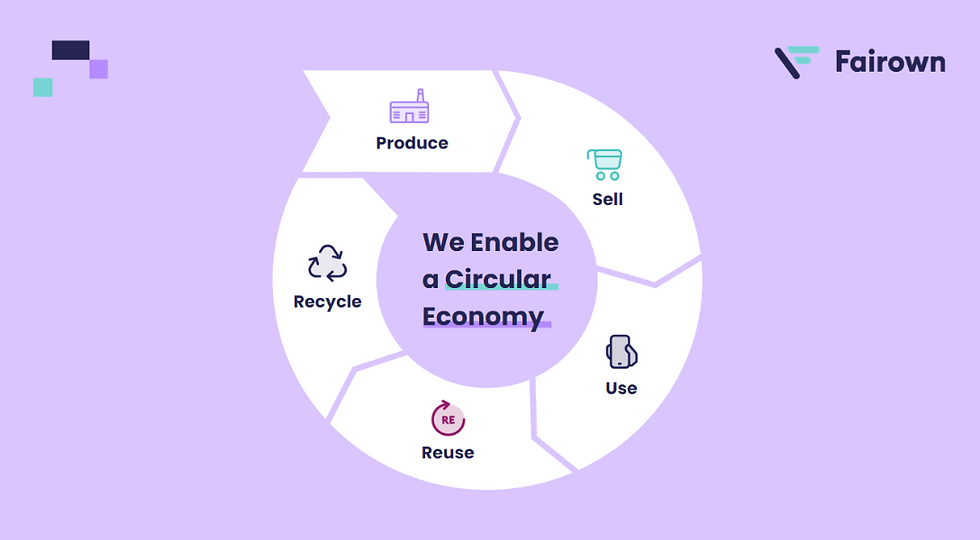Can Unsecured Lending Enable the Circular Economy?
- Hendrik Roosna

- Nov 15, 2022
- 4 min read
Updated: Sep 19, 2024
Is there a way for unsecured lending to act as a circular economy enabler? That depends on a variety of factors starting from understanding real-time consumer behaviour to realising how creditworthiness affects payment behaviour and how product can be used as a collateral. But also, whether businesses use the right technology to succeed in providing unsecured lending for social good.

Understanding Real-Time Consumer Behaviour Is Key
Companies who provide unsecured lending have a unique market position. The nature of the lending business is about accumulating data and building probability-based prediction whether the consumer is willing and able to serve the liability taken.
Lenders need to solve questions like how to motivate consumers to pay the amount of money they are about to lose. They need to understand that this business, methodology, and behaviour have been formed over hundreds of years by evolutionary processes based on the market economy.
The survivors of the credit world know that claiming something back from consumers has different risk dimensions:
credit risk related to defaulting on a debt if the borrower fails to make required payments;
operational risk related to flawed or failed processes, policies, systems, or events that disrupt business operations, e.g. criminal activity, fraud, etc.
Creditworthiness as an Influencer of Payment Behaviour
It’s important to note who owns the product. Wouldn’t product ownership make a difference in unsecured lending? Could the product be used as a collateral? A good way to simplify this is by using pledging as an example. There can be various scenarios of who owns the product: the lessor, the rental service provider, or the product is pledged as a collateral.
There are three types of pledges:
positive - the service provider can be quite sure it gets the pledged asset and can sell it to cover the liability. For example, a real estate mortgage, a car leasing or loan;
negative - consuming a service depends on whether the consumer pays for it. If he doesn’t, the service provider can’t get back the service provided. This type of pledge improves payment behaviour. For example, utility and carrier bills;
neutral - this type of pledge adds too little value to actually change payment behaviour.
The latest financial crisis has taught us that collateral itself, no matter how good, does not solve the problem. If the consumer doesn’t have a willingness to pay or means to service a liability, the pledge becomes irrelevant.
Unsecured Lending for Social Good
Consumers tend to lend when they are in trouble or overspending. Lenders have taken advantage of these situations and hurt the reputation of the business of unsecured lending. Nevertheless, as a fundamental building block of the economy, lending can also be used for doing good and enabling the circular economy.

What is the circular economy? It is a concept, centred around producing, consuming and reusing products, thereby reducing both excessive waste and the need for raw materials by extending products’ lifetime value. The more we keep old and used products in circulation, the bigger the effect on social good.
Technology That Helps You with Enabling the Circular Economy
The circular economy approach underpins Fairown’s technology. We have developed a concept where local banks and global brands can work together to manage the life cycle of consumer electronics devices’.
We offer a complete suite of software and services to manage the entire product life cycle from purchase to periodic renewals, repurposing and/or recycling. We have brought the subscription model, which is common in the service industry, into the hardware sector.
Our payment platform allows banks, brands, and retailers to participate in the circular economy and offer products for monthly subscriptions. We help environmentally-conscious businesses launch products-as-a-service offerings, so that together we could reduce excessive waste.
How does it work? A deal is made with a consumer at the point of sale:
it determines for how long the consumer will use the device being purchased;
a local lender will finance this plan.

This unique partnership requires three crucial members, each of whom has specific responsibilities:
Fairown provides the financial technology and manages product renewal cycles;
a local bank provides product financing;
a brand or retailer sells products to consumers.
Predictable Product Life Cycles to Reduce Waste
The main advantage of a subscription plan is fixed product life cycle management. This means that consumers get the product and use it over a recommended lifetime. Fairown adds a financial initiative for consumers to keep the product in a good condition and hand it over at the right time. Timing is crucial, as one’s old product will be another one’s new.
To put this into perspective, over 80 000 litres of water is used to produce one single smartphone. And, unfortunately, just over 17% of the world’s e-waste is properly recycled. We need to learn how to keep products in circulation much more efficiently. Unsecured lending is a perfect tool to break old habits and orchestrate new, greener behaviours.
Curious about how to provide product financing to your customers in a sustainable way? Reach out to us, we can help you set up a subscription offering in just 2 weeks!


